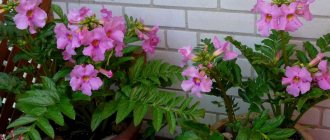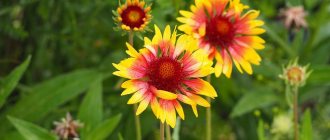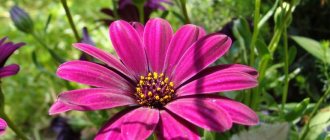Calistegia came to our gardens from Japan and Northern China. In Central Asia and the Far East, this plant is widespread as wild. Gardeners loved its fast growth, endurance and beautiful flowering. Calistegia of double varieties, with delicate voluminous buds so similar to roses, began to be called “Siberian rose” and “French rose”. There are also other names for loach and loach. The name is translated from Greek as “to cover the calyx”; a large beautiful bract covers the calyx of the flower. The calistegia liana quickly entwines fences and gazebos and hides outbuildings under beautiful greenery and flowers.
Description of the plant
With not the most powerful stems (the usual thickness rarely exceeds 4 mm), calistegia has an impressive root, extending horizontally up to 1.5 meters. In garden plots, if it is not limited in the ground by metal or other barriers, the loach is quite capable of escaping far beyond the boundaries of its allotted place, turning into a harmful weed.
The flowers grow singly from the leaf axils and range in color from pale pink, almost white, to deep pink. The size of the corolla in different breeds can range from 3 to 7 cm in diameter.
The oblong leaves are similar to grape leaves, although they are two to three times smaller in size. The vines' vines are capable of clinging to their tendril-like leashes and rise to a height of up to 4 meters, and with good soil under the roots they are able to cover their favorite objects with a continuous carpet.
Breeding and planting
Calistegia is propagated by dividing the rhizome. Thanks to high regeneration, even a small piece of root is able to sprout shoots.
At the end of autumn, the plant needs to be dug up and stored in boxes. Throughout the winter, it is necessary to ensure that the soil around the roots is moist.
With the arrival of spring, the rhizomes must be completely freed from soil and divided into small pieces. So, to form a new plant, a length of 5-8 cm is enough.
Sections of rhizomes are planted in pots to a depth of about 3 cm. In order for the seedlings to grow, this must be done in early March. The seedlings will not take long to appear and will begin to grow quite quickly. As soon as their length reaches about 5 cm, the plant needs to be pinched. Otherwise it will be long and not thick. It will be inconvenient to plant in this form.
Already in mid-May, seedlings can be planted in open ground. To prevent Calistegia from growing, the rhizomes must be limited. This can be done using a mesh or small pieces of slate.
It is not recommended to plant the plant in buckets or other similar containers. If the root system does not have enough space for further development, the bindweed may die.
Application of calistegia
Most often, calistegia (if these are inexpensive or just wild varieties) is planted to hide a not very good view of a barn, fence, or some kind of outbuilding. More noble varieties are settled on verandas, gazebos, or simply on decorative trellises specially placed for this purpose.
Calistegia is an irreplaceable plant in this regard: in the first year of life, if its cuttings are planted densely enough, it is capable of covering any flaws in the landscape with a solid green blanket.
Terry calistegia: types and varieties for open ground
Fluffy
Country of origin: China. The stem of the vine is long, capable of climbing to a height of up to 4 meters; the vascular system of sap ducts in the body of the vine cannot cope further. In winter, during frosts, the ground with roots should be covered with a layer of fallen leaves. The flowers are large, in the form of double bells, the diameter of the inflorescence can reach 9 cm.
Hairy
In Russia it lives throughout the Far East. The shortest type of calistegia, the length of the vine does not exceed 80 cm. The foliage is yellow-green, flowers with fused petals, flat-bell-shaped, pale pink, with a corolla diameter from 3 to 6 cm.
Fence
The fastest growing species. Similar to a young birch tree in the shape of its branches and leaves. It reproduces by self-seeding, and in a couple of years it is capable of entwining everything it can cling to with long tendrils. Refers to weeds.
The leaves are triangular, leathery, the length of the vine is up to 3 m, the flowers are white or with a subtle pink tint. Capable of crossing with other types of calistegia.
Multiplex
Liana with a stem length of up to three and a half meters. A decorative look that is not afraid of severe frosts. The stem dies off in the winter, but this calistegia shoots out from the roots a month and a half before its maximum growth.
The leaves are ordinary, triangular, slightly cut. The flowers are pink, double, with a pearlescent sheen, up to 9 cm in diameter. They are long-blooming - from July to October.
Ivy or Japanese
Belongs to medium-sized varieties, the vine rarely grows to 2.5 m. Flowering lasts from mid-July to September, by which time growth stops. The usual flower size is from 7 to 9 cm, the leaves are medium sized, bright green.
Calistegia and vertical gardening
This vine is designed for vertical gardening projects. Of course, in your garden there are gazebos and small arches where bindweed will feel great. An ordinary chain-link can be an excellent basis for a beautiful hedge. You see any calistegia in the photo near some kind of support. So, the purpose of this plant is to twine and braid. Without support, calistegia does not grow well and may refuse to bloom, so the gardener’s main concern is to provide this vine with decent support:
- Calistegia beautifully wraps around columns, thin columns and poles. If the diameter of the pole is too large, you need to stretch the wire around the vine in a circle. Calistegia terry can hide any unsightly garden supports.
- You can decorate the perimeter of the façade of your house with calistegia liana. It is necessary to encircle the contour around the door with a narrow strip of mesh. Liana will perfectly highlight the architecture of classical columns. This option is ideal for an English-style home.
- A vine like calistegia looks great in the flora of captivity in an arch. The perimeter of this arch can be made in the form of a narrow mesh strip. Calistegia is planted in two places, at the base of the arch, and the branches are directed towards each other.
Since calistegia, even terry, does not form a panorama or a dense mosaic in the garden, it can be combined with some other beautiful vines. It could be, say, clematis.
Calistegia liana is quite suitable for a pre-planned special event. For example, if a wedding is being celebrated at home in a few months, you can have time to plant two or three rhizomes in the intended place, and soon lush pink buds will delight the eyes of guests. So, calistegia, despite its aggressive nature, can become one of the most favorite plants in your garden.
Planting in open ground
Landing dates
Root shoots of calistegia can be planted in early spring or late autumn, shortly before snowfall.
But in the second case, it is necessary to insulate the ground with mulch in the form of fallen leaves, spruce branches, straw, peat, etc. In the spring it can be propagated by cuttings. To do this, cut off the stems with three to four buds and leave 2-3 top leaves. The place of the lower cut is treated with a root formation stimulator (“Kornevin” or the like), dried for about an hour and water is added until the cuttings release roots.
Only wild plants reproduce by seed material; hybrid forms have sterile seeds.
Choice of location and lighting
The planting site is chosen next to any vertical wall to which the plant can cling with its tendrils. Calistegia can attach to trees only if its trunk diameter does not exceed 8-10 cm. Or its bark should have deep vertical and rough grooves.
The best option would be special trellises, strings stretched near the fence from bottom to top, or lattice structures of gazebos or verandas.
Illumination plays a greater role in cultivated forms, although none of the representatives of this family, even the most unpretentious, will want to grow in the shade. If a plant has settled in the shade of a tree, you can immediately say with confidence that the crown of such a tree is openwork and the shade is appropriate.
Soil preparation
Liana loves loamy and sandy soil. You just need to provide annual feeding with compost and mineral fertilizers - this is especially important for cultivated varieties. The close occurrence of groundwater is unacceptable, even seasonal (after the snow melts in the spring)
Landing rules
A groove is dug to the depth of the bayonet of the shovel. It is filled with a mixture of loose soil with ash and humus, as well as with the addition of a mineral complex. Rooted cuttings are planted in the holes made at a distance of 5 to 15 cm from each other, depending on the type of calistegia.
Then, at a distance from the planting, to a depth of 40-45 cm, vertical sheets of slate are dug in, which will prevent the plant from turning into a weed and filling the entire space of the garden or vegetable garden.
Sometimes they even cut iron barrels - a 200-liter barrel is stripped of its bottom and lid, sawed crosswise in half and dug into the ground in this form (rings), planting 5-10 cuttings inside. Their horizontal roots will definitely not escape from such a trap!
Caring for calistegium terry
Watering
Calistegia terry is not harmed by short droughts, since its developed root system is capable of making certain reserves of moisture. However, if the drought is prolonged, then the vine will need to be provided with systematic watering. Water the bushes 1 or 2 times a week, using such an amount of water that the soil is wet to the depth of the root system (about 20 centimeters). It is also recommended to regularly wash the foliage to remove dust.
To reduce the evaporation of moisture from the ground on hot summer days, its surface should be covered with a layer of mulch. This will also protect the root system from overheating.
Fertilizer
In order for the vine to bloom magnificently, it requires regular feeding. It forms buds from the first days of July until the end of the growing season. In this regard, in the spring, the soil is fertilized with organic fertilizers for the growth of powerful shoots, and in the summer months - with a mineral complex, which includes potassium and phosphorus. Feed calistegia 1 or 2 times a month. In autumn, the soil surface can be covered with a layer of wood ash.
Trimming
The lifespan of a flower is about 7 days. Then it withers and continues to hang on the shoots, spoiling the appearance of the plant. Therefore, their systematic removal will help maintain the neat appearance of the vine. Such sanitary pruning is carried out once every 7 days. After the first autumn frosts, you need to cut off all the stems of the plant at the root.
Transfer
Adult bushes react extremely negatively to transplantation; therefore, it is recommended to immediately select the most suitable site for planting them. The liana can grow well on it for 10–25 years, and then it is renewed by dividing the rhizome. Calistegia is transplanted only in spring or autumn, and this is never done in summer.
Wintering
Mature powerful bushes do not need to be covered for the winter, as they can withstand temperatures as low as minus 30 degrees. However, young seedlings are characterized by low resistance to frost. Until the plant is three years old, in the autumn, after pruning, the surface of the area will need to be covered with a ten-centimeter layer of mulch (humus or peat).
To prevent the root system from drying out, the shelter must be removed from the beginning of March to mid-April. In this case, young shoots are covered with film if necessary. The awakening of calistegia begins in the last days of May.
CALISTEGIA TWICE-FRENCH ROSE.
Outdoor care
Watering
The plant drinks water very sparingly; as a rule, it has enough water from rain. Abundant watering is only needed in dry summers, and in excessively rainy summers the bindweed can even die from root rot.
Feeding and fertilizer
Fertilizers can be applied during the entire growth period. But especially intensive application can be done in the spring, as the root system forms and the calistegia gains green mass. During the flowering period, moderate feeding is required. Before wintering, it is advisable to mulch the soil in the planting area with wood ash.
Bloom
Flowering begins as early as the year of planting and in some species can last from the beginning of July until frost. The splendor of flowers depends mainly on lighting conditions; the more light, the more magnificent and brighter the flowers. Removing or not removing dried flowers does not affect the well-being of the vine, it is only a matter of aesthetics.
Trimming
The plant is an annual, so the entire vine from the root node to the top dies in late autumn. At this time, sanitary pruning is done, removing the whip from the root, and burning it. In the spring, weak shoots that are lagging in growth are also pruned.
Sometimes you have to do pruning and roots - if they managed to “escape” the restrictive barriers.
Transfer
This process is not mandatory, and is used only if the owner of the site needs to change the location of the flower. Here you will have to work hard: calistegia of all varieties is an extremely tenacious resident of the garden, and you can’t just uproot it.
And in order for the transplanted plant to take root safely in a new place, only the root system is transplanted, and then in the fall: calistegia tolerates summer transplantation very poorly.
Growing bindweed
Plant propagation
Calistegia has no problems with reproduction. Even a small piece of root will grow into a vine. Therefore, ornamental plant varieties are propagated by root division. If the plant does not tolerate winter cold, the root is dug up, placed in a box, covered with soil and stored until spring planting. In winter, the soil is moistened.
Planting a vine
When planting, the root is divided into pieces. In the place where the cuts are, they are treated with crushed tablets of activated carbon or crushed charcoal. Planting depth is 3 cm. These root pieces are planted in peat cups and watered abundantly. When the development of the rootstocks begins, the tops are pinched off. This will make the bush thicker.
In the second half of May, these bushes are planted in the place where you want to see the beautiful liana. Don't forget to protect the roots from spreading.
Protection from pests and diseases
The plant has good natural immunity. The only disease to which it may be susceptible is fungal infections of the roots in years with heavy rainfall. Then you need to remove the diseased parts, and treat the plants themselves with fungicides. And provide conditions. In which the soil will not become waterlogged.
Of the parasites, it is affected by spider mites - which happens, on the contrary, in dry years. The fight against them is the use of insecticides.
Sometimes the vine is attacked by garden snails or slugs. These are collected by hand, and broken eggshells are scattered around on the soil.
Aftercare
Calistegia is an unpretentious plant to care for. The key to good growth is the right location. Bindweed prefers sunny areas, with moderately loose and fertile soil.
Watering should be moderate. Calistegia can tolerate a slight drought without loss, but does not like heavy moisture. If you water too much, the plant may get sick. If it is affected by root rot or powdery mildew, then it is rational to use the drug “Fitosporin” for treatment. They need to spray the plant. After illness, Calistegia recovers quite quickly if treatment is started on time.
The plant needs to be fed twice a year - in September and May. In spring, cow or leaf humus will do. In autumn, you need to use universal mineral complexes.
For wintering, it is better to dig up the plant and put it in boxes for storage. But if you don’t do this, you can simply cut off the shoots and cover the roots with sawdust or other insulation.
Reproduction
Reproduction is vegetative, mainly using rooted shoots or root segments with buds.
Root propagation, subject to antiseptic rules, is practiced throughout the growing season. The cuttings are rooted in a peat-sand mixture, and to create a greenhouse effect they are covered with cut-off parts of plastic bottles upside down.
Autumn care, shelter
Only plants one or two years old need protection from winter cold. Older, fairly rooted plants survive frosty periods without problems.
Preparing for winter
Calistegia terry is a frost-resistant plant. And in the middle zone, it calmly endures the cold season even without shelter. But if a frosty and snowless winter is expected, then it is better to prepare the crop for it. To do this, cut off all above-ground parts of the plant, because they will die from frost anyway. After this, sprinkle the vine's trunk circle with fallen leaves, peat or sawdust.
Calistegia in landscape design
The ideal solution for using calistegia in landscape design is the organization of hedges that visually expand the space. For this purpose, the technique of an arch passage between different zones of the site is often used.
Solid, but sometimes with breaks, green walls can hide unattractive elements of the landscape (most often man-made, which do not fit well into the architect-designer's plan). For this purpose, spring planting of cuttings or sections of rhizomes with growth buds is planted at a distance of 5 to 10 cm from each other.
When arranging a solid wall, remove other flowers from the proximity of bindweed - it will not allow anyone to grow and will drown out any extraneous phytoactivity.
How to care
Watering
No special care is required for calistegia. This plant is distinguished by its unpretentiousness: it can tolerate both cold and drought. During the rainy season, there is no need to water the plant, but on hot, dry days, try to keep the soil moist.
The soil
Don't forget to loosen the soil with a pitchfork. Do this not too deep - 2-3 centimeters is enough.
Top dressing
Due to the rapidity of its growth, calistegia requires feeding. Do this systematically and with specialized mineral fertilizers. The plant should also be fed before the start of the growing season. This is done in early spring with the help of organic fertilizers and humus.
Trimming
It is also important to pick off drying flowers so that new ones can grow in their place. This must be done throughout the flowering period. After the growing season, be sure to prune old shoots. Thanks to this, the plant will endure the winter easier and produce more flowers in the spring.
Wintering
As mentioned earlier, calistegia is a fairly frost-resistant plant. However, if the winter promises to be little snow and harsh, take care of shelter for the rootstock in advance. Cover the plant with peat or dry fallen leaves.
Transfer
You can replant Calistegia pova, but not in the summer. During this period, the plant’s roots are too active and replanting can destroy them. But in the fall the transplant will be safe. Try not to plant the rootstock next to flower beds, otherwise the calystegia will take over the entire surrounding area.
Reproduction
Calistegia can only be propagated at home using the vegetative method. To do this, take the root cuttings and replant them in previously prepared soil.
Need for transplant
The root system of Calistegia ivy is characterized by aggressive growth. If you do not monitor its condition, it will destroy nearby plants. Therefore, after planting, the bindweed is protected.
The transplant process is optional. It is necessary only when the owner of the site needs to change the location where bindweed grows. But in this case, you will have to work hard, since Calistegia ivy-leaved is a tenacious flower.
You should not replant the plant where the space is too small, as this will lead to the early death of the plant.
If a gardener decides to engage in this process, then you should not do this in the summer. But in spring or autumn, Calistegia ivy-leaved grows quickly, takes root and grows well.
How to make calistegia part of the landscape
Povoy is ideal for decorating your garden. Long vines can be used as hedges, and also decorate fences or arches.
Bindweed will quickly grow and decorate your area, while requiring a minimum of attention. The main thing is not to overwater the plant and give it the necessary amount of light.
Why does the plant dry out and turn yellow?
Unless this is seasonal, completely natural wilting, then yellowing of the leaves is an alarming sign that may indicate:
- deficiency or excess of moisture;
- diseases of the root system (root rot);
- damage by powdery mildew or pests;
- lack of nutrients in the soil.
If in the first case it is only necessary to change the watering regime, then for all other reasons for early wilting, more complex actions will be required.
Where to buy and cost of the plant
Most often, buyers are offered Siberian rose (rhizomes or young plants) at a price of approximately 500 rubles. for 1 copy, and Calistegia japonica (ivy-shaped, Flora Plena) - approximately 530 rubles. per copy. It is advisable to place an order in the winter; delivery times from most stores are March-April.
Calistegia in the form of rhizomes, cuttings, and seedlings can be purchased in any online store aimed at amateur gardeners. The cost will depend on the specific variety. It is also important not to forget about the rules of planting and caring for the plant.
Growing astilbe from seeds
Pawpaw planting and care, growing in soil
Planting astilbe seeds Photo of seedlings
Astilbe is sown for seedlings in March; the seeds are placed in prepared nutrient soil (suitable for universal soil or for flowering plants). You can carry out stratification, which will strengthen the biomaterial, the plant will be ready for temperature changes.
1 cm of snow is placed on a soil made of sand and peat in a 1:1 ratio, which, when melted, will sink the seeds into the ground, strengthening them. To harden, the container with ungerminated seeds is placed in the refrigerator for 15-20 days, thereby preparing the future plant for low winter temperatures. Afterwards the container is placed in a warm, well-lit place.
Germination and growth of seeds will be better at a temperature of 18-20 ºС. Water the seedlings carefully, without stagnating water, without damaging weak sprouts. When sowing in a common box, picking will be required, so after the formation of 2-3 true leaves, the plants are planted in spacious boxes or individual containers for seedlings, a distance of at least 6-7 cm.
The soil where the seedlings will be planted should be loamy, preferably near groundwater or an artificial reservoir. Some species can adapt to the sunny side, shortening the flowering period, but the northern shady side is preferable for the flower. The hosta is considered an ideal neighbor; its leaves cover the ground, carefully protecting it from the hot afternoon.
Important! It is best to plant in May, when the risk of frost has passed. Pre-adapt the bushes to the street night temperature by taking the seedlings into the open air











